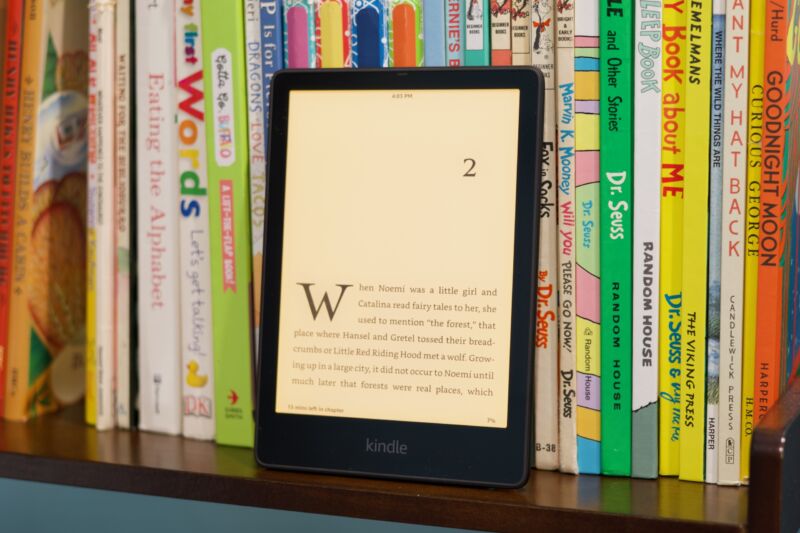

Review: Bigger screen, better lighting make for a nearly perfect Kindle Paperwhi...
source link: https://arstechnica.com/gadgets/2021/10/review-bigger-screen-and-better-lighting-make-for-a-nearly-perfect-kindle-paperwhite/
Go to the source link to view the article. You can view the picture content, updated content and better typesetting reading experience. If the link is broken, please click the button below to view the snapshot at that time.

yellowed paperwhite —
Review: Bigger screen, better lighting make for a nearly perfect Kindle Paperwhite
Amazon's best Kindle gets better, albeit slightly more expensive.
Andrew Cunningham - 10/27/2021, 6:45 PM

It's the most reliable upgrade in tech: take a thing that was already good, and make the screen bigger.
From laptops to TVs to phones to game consoles to tablets to watches, the time-honored tradition of making the screen bigger has resulted in some excellent upgrades, at least as long as making the screen bigger doesn't screw up anything else.
And that's Amazon's playbook with the $140 11th-generation Kindle Paperwhite. Next to the 10th-generation model, the designs look nearly identical, but the new one has a larger screen enabled in part by slimmer borders around the top and sides.
But just because the bigger screen is the most noticeable thing about the new Paperwhite doesn't mean it's the only thing. It now has a USB-C port for charging, replacing the aging micro-USB port. Performance is improved in small but noticeable ways. Its frontlight adds more LEDs, so the illumination looks smoother and more uniform, and it also picks up the auto-brightness sensor and warm light features from the $250 Kindle Oasis.
All of that comes together in a $140 e-reader that is the best Kindle—and, by extension, the best e-reader—that you can currently buy.
Bigger screen with a better frontlight

The headline feature of the new Paperwhite is its 6.8-inch screen, a big step up from the old Paperwhite’s (and the standard Kindle’s) 6-inch display. It doesn’t change the Kindle’s user interface much, but it does mean a lot more words per page when you’re using the same font sizes, margins, and spacing.
The space for the larger screen mostly comes out of the Kindle’s top and side bezels, which are much slimmer than before (though the bottom bezel is a little thicker than before, likely to ensure that you still have plenty of room for your thumbs while you’re holding the device). Even with the bezel tweaks, the new Kindle is taller and wider than the old one, but not so much that it feels harder to hold for extended periods. The design of the 11th-generation Paperwhite and the 10th-gen Paperwhite are otherwise identical, with bezels that are flush with the display and the same soft-touch plastic back.
Advertisement-
An adjustable warmlight can also make the new Paperwhite easier on the eyes.
-
Color temperature and brightness are adjusted separately in the Kindle's settings.
-
The cutout for the auto-brightness sensor is faintly visible at the top-center of the device.
The new Paperwhite also gets an upgraded frontlight that makes it a lot more like the more-expensive Kindle Oasis. The frontlight now uses 17 LEDs, up from five in the last-gen Paperwhite and four in the standard Kindle. And it now has a warmlight option that can shift the display’s color temperature from the standard cool blue to a warm orangey-yellow.
Two separate sliders control backlight brightness and the light’s color temperature. Even if you don’t care for the yellow display effect that most phones/tablets/computers offer now, turning the display warmth up a few ticks takes the harsh edge off of the bluish Kindle frontlight and makes the display a lot more pleasant to look at. A built-in auto-brightness sensor also helps with this.
The Kindle Oasis has still-more LEDs in its 7-inch screen—25, instead of 17—but the Paperwhite’s screen is so bright and evenly lit that I doubt I could tell the difference even with the two devices next to each other.
Better performance (with one serious bug)
Amazon claims the new Paperwhite has “20% faster page turns,” and while I didn’t measure anything with a stopwatch, the 11th-gen Paperwhite did feel more consistently responsive than 10th- and 7th-gen models I normally use. That's true not just for page turns, but also for navigating menus, highlighting passages, and typing out quick notes. The new Paperwhite is still occasionally prone to the kinds of random, inexplicable minor hangups and hitches that all Kindles I’ve used have sometimes suffered from, but those pauses take less time to resolve themselves than they do on the older models.
AdvertisementThat said, I can consistently get the new Kindle to totally lock up by rapidly adjusting the backlight and warmth sliders and then opening a book—almost as though giving the screen too many inputs in too short a time makes it stop responding entirely. The frontlight will still turn on and off, but the display won’t refresh or respond to input until the device has been hard rebooted.
I suspect that this is a bug that can be resolved with a software update, and it’s not something you’ll run into if you’re not tweaking the settings a bunch in a short period of time. But it’s something to be aware of—I’ve contacted Amazon to see whether this is a known issue and if a fix is coming.
Page:
Recommend
About Joyk
Aggregate valuable and interesting links.
Joyk means Joy of geeK